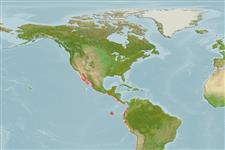Actinopterygii (ray-finned fishes) >
Beloniformes (Needle fishes) >
Belonidae (Needlefishes)
Etymology: Strongylura: Greek, strongylos = round + Greek, oura = tail (Ref. 45335).
Environment / Climate / Range
Ecology
Marine; freshwater; brackish; pelagic-neritic; depth range 0 - 100 m (Ref. 96339). Subtropical, preferred ?; 33°N - 15°S, 118°W - 11°W (Ref. 56981)
Eastern Pacific: San Francisco in California, USA to Peru, including the Galapagos Islands.
Size / Weight / Age
Maturity: Lm ? range ? - ? cm
Max length : 91.0 cm TL male/unsexed; (Ref. 2850); common length : 50.0 cm SL male/unsexed; (Ref. 9279)
Common in coastal and lagoon areas with mangroves (Ref. 9279). Also found in bays and harbors (Ref. 36575). Penetrate fresh water (Ref. 9279). Adults occur in small schools. Feed mainly on small fishes (Ref. 9279). Oviparous, with neustonic larvae (Ref. 36575). Eggs are attached to vegetation and floating objects via long filaments (Ref. 36575). Usually caught with the help of artificial lights (Ref. 9279). Marketed fresh (Ref. 9279).
Life cycle and mating behavior
Maturity | Reproduction | Spawning | Eggs | Fecundity | Larvae
Eschmeyer, W.N., E.S. Herald and H. Hammann, 1983. A field guide to Pacific coast fishes of North America. Boston (MA, USA): Houghton Mifflin Company. xii+336 p. (Ref. 2850)
IUCN Red List Status (Ref. 115185)
CITES (Ref. 94142)
Not Evaluated
Threat to humans
Harmless
Human uses
Fisheries: minor commercial
More information
ReferencesAquacultureAquaculture profileStrainsGeneticsAllele frequenciesHeritabilityDiseasesProcessingMass conversion
Tools
Special reports
Download XML
Internet sources
